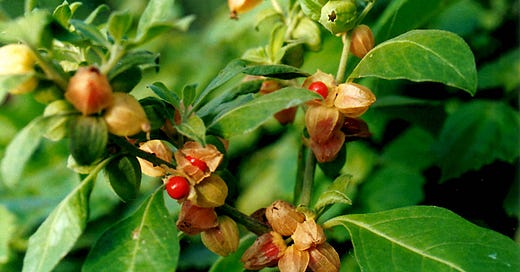Ashwagandha has become a very popular herb over the last number of years, and rightly so. It is a deeply acting, tonifying root that helps rebuild depleted energy and helps to regulate the nervous system. It has an overall balancing effect on the endocrine system, being indicated in what if often referred to as “adrenal exhaustion”, or HPA axis dysregulation. It supports the thyroid gland, being indicated in both cases of hyper and hypothyroid.
Being considered an adaptogen, it helps us better respond to stress. However unlike many adaptogens, it is also considered a nervine, which means it has an overall relaxing effect on the body. This is not a common property in most adaptogens, which puts Ashwagandha in a special place, being especially helpful for those people who, though being burnt out, have a hard time slowing down. For many people, when they have burnt the candle at both ends for far too long, the last thing they need is an herb that is going to wind them up and get them to take on even more stress.
It has been used in traditional Ayurvedic medicine for centuries, where it is considered to be one of the main rejuvenative tonics for men. It has been shown to increase testosterone levels. It is also used extensively to support fertility for women and help ease the transition through menopause.
It protects the brain from damage, helps support cognitive function, reduces tension and spasm in the body, and has been used traditionally for neurological disorders including seizures and convulsions. Withania somnifera is the latin name of the plant where “somnifera” refers to sleep. It’s an adaptogen that helps regulate the nervous system in order to support deeper sleep.
The name Ashwagandha translates to “scent of a horse”, as the fresh roots smell like horse’s sweat or urine and it is known to give stallion like strength. It certainly has a stronger odor/taste that is not the most pleasant.
It is bitter, astringent and sweet in flavour, most indicated for thin, dry, nervous, jittery types of people. While it is generally considered a safe herb to take in higher than average doses of up to 10 grams per day in acute cases, it is not recommended in those who tend to be lymphatic or are experiencing congestion, as it can increase mucous tendencies. It is traditionally prepared in a milk decoction, or as a preparation with ghee. Most traditional recipes include ginger or some other warming spice to be taken together with it. When preparing the root as a tincture, it is recommended to use the dry not fresh root. While available in capsule form, I do like using the root in a powdered form as it brings me more connection to the plant. Many people find they can get away with adding it into their smoothie, especially if their smoothie contains stronger flavours such as cacao. It is not pleasant in flavour, especially when taken on its own. I find it works best for me in a preparation of ghee with some spices, where taking a teaspoonful at a time is just fine, and I actually quite enjoy it.
Being a nightshade plant, it is in the same family as tomatoes. In our region, it can be grown as an annual as it does not overwinter in the cold. In warmer climates it grows as a small woody shrub. If you want to try growing some in your garden, plants are available both from Firmly Rooted and Richters.





